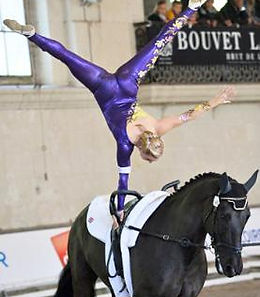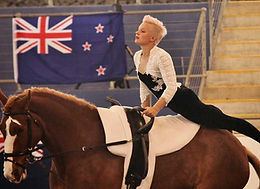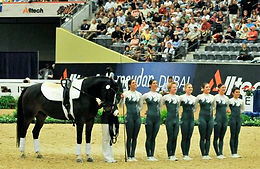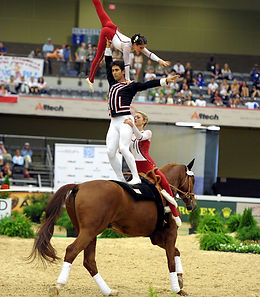
Ripplebrook Equestrian Vaulting Academy





What is Vaulting?
Equestrian vaulting can be dated back to the pre-romantic Ice Period in southern Scandinavia. Stone paintings depict horses with persons standing on them, portraying what was considered "artistic riding". Vaulting was also seen in the Classical Olympics in Ancient Greece, and in the Roman games. Julius Caesar, in his famous "De Bello Gallico", mentioned the excellent riding skills of the Germans.
The most recognised roots of this equestrian discipline come from the Middle Ages, where vaulting was a part of the education of knights and noblemen. During the Baroque era, this sport was generally regarded as a means of expressing personal wealth and good taste. The modern name of this sport stems from the French "la voltige", used through this period.
Every graduate from a higher military education in cavalry troops regarded vaulting as a prephase for an advanced equestrian education. The "wooden horse" was used for training purposed. These days, vaulters use a "vaulting barrel" to practise movements before progressing to the horse.
Vaulting was included in the 1920 Olympic Games in Antwerpen, under the title of "artistic riding". The team gold medalist was Belgium, followed by France and Sweden.
Modern vaulting, much as it is practised today, was developed in postwar Germany as a means of introducing children to equestrian sports. In the sixties, vaulting moved to neighboring countries and the United States. Vaulting is still a prerequisite to traditional english-style riding in Germany, as the art of vaulting develops a rider's seat, positioning and balance, all essential to becoming harmonious with the horse.
In 1983, vaulting became recognised by the Federation Equestre Internationale (FEI). The first European Championships took place in 1984 in Ebreichsdorf, Austria, and the first World Championships in 1986 in Bulle, Switzerland. Vaulting was first included in the World Equestrian Games in the 1990 Stockholm games, and has been a part of this prestigious event ever since. It was demonstrated as an art during the 1984 and 1996 Olympic Games. Vaulting has been included in the Inter Africa Cup since 2006. The first World Cup Vaulting competition was held in Leipzig in 29-30 April, 2011.
Vaulting in Australia
Vaulting is run through both Riding for the Disabled Association, and through incorporated individual groups. In Australia, competitive vaulting is organised and run by groups of volunteers in each State, via Equestrian Australia Affiliated Clubs. Currently, there are over ten incorporated vaulting non-profit organsations and together they form the backbone of vaulting in Australia.
In addition, there are many coaches that have undertaken training and assessment through the Equestrian Australia Education Program, which provides a pathway for vaulting coaches to develop their skills and become nationally recognised via the National Coach Accredited Scheme and can be located in each state on the EA Coach Search Database.
The state branches of Equestrian Australia have discipline sub-committees, and our volunteers from the general community hold positions on these vaulting specific committees, overseeing competitions and developing vaulting within each state. Western Australia is yet to form a vaulting sub-committee, however with the profound growth in recent years, we are not far off having a committee of our own.
In addition to state committees, there is a national vaulting committee that governs the rules of our sport and looks after our high performance interests at national and international level. To compete at State or National Championships, all vaulters are required to be members of Equestrian Australia, and can join via their EA state branch.